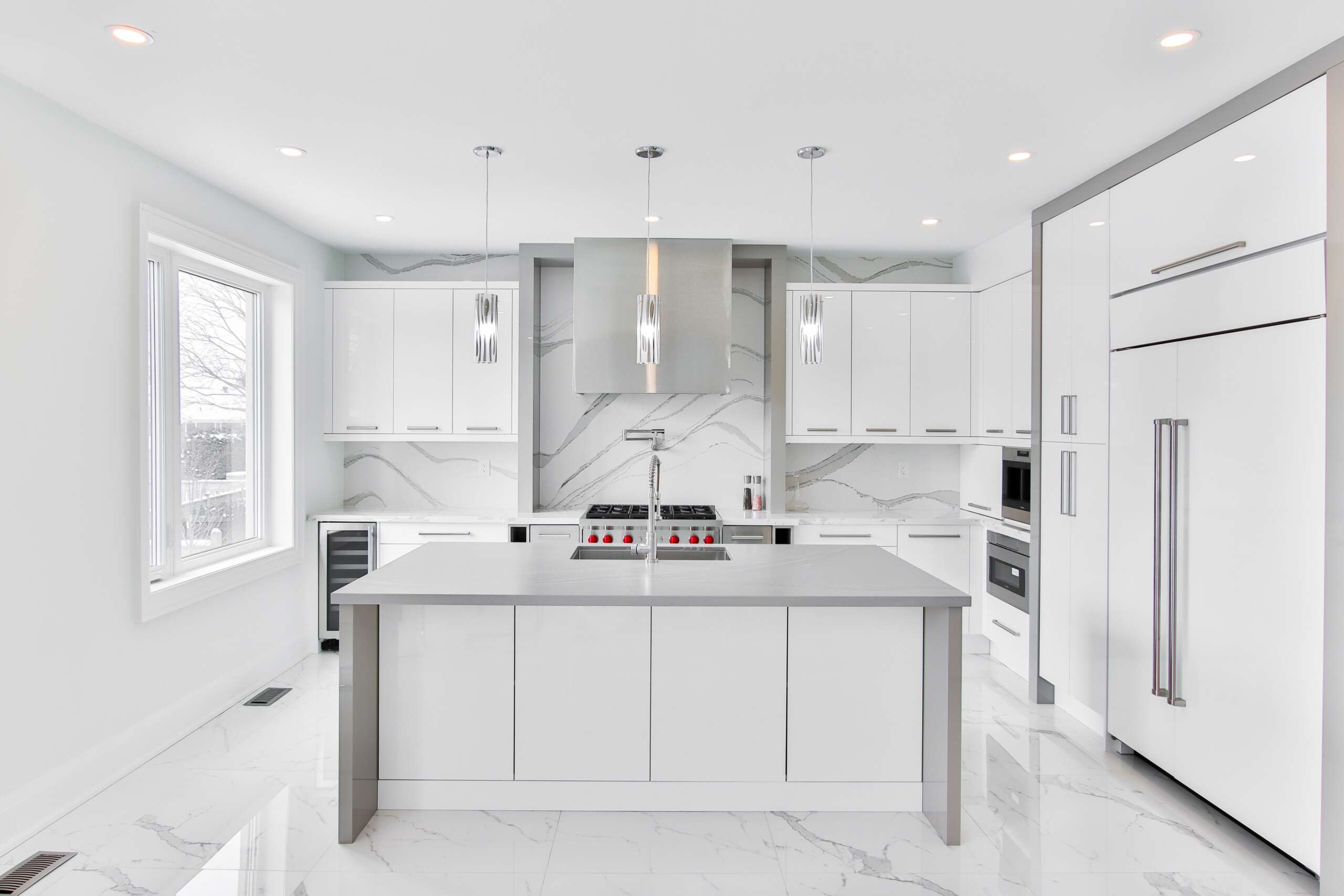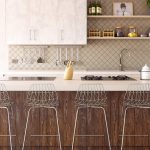Porcelain and Ceramic Tiles
Porcelain and ceramic tiles are two of the most popular materials for kitchen remodeling. Offering many features, they come in a variety of colors and styles. They are primarily used for floorings, wall surfaces, backsplashes, and countertops. At first glance, they may look very similar, but they are a lot of differences between the two. The decision on whether to use each of them depends on your preferences and also taste.
In this article, we will compare the differences between porcelain and ceramic tiles to help you make a more informed decision and achieve your desired performance and style.
Contents
What makes porcelain and ceramic different?
Tiles are often made from clays with different compositions and then will be fired. Any difference in this process can create a very different tile in terms of its look and characteristics:
Base materials
Porcelain tiles are made from fine-grain kaolin clay or china clay containing mainly kaolin mineral and also quartz, hardeners, and resins. Kaolin is named after the hill in China (Kao-ling) from which it was mined for centuries. It is a white and soft mineral produced by chemical weathering of aluminum silicate minerals like feldspar. Tiles made from this clay are fine yet stronger.
Ceramic tiles are made from ceramic clay which consists of minerals found in Earth’s crust. This clay is coarser and contains smaller proportion of kaolin and additives. It often has iron oxide that gives it a reddish hue. Tiles made from this clay are coarse yet less strong.
Processing
The main factor that distinguishes different methods of tile making is the number of times a tile is baked. After the ingredients are mixed, they form a body slip, which is put in a kiln. It is fired to lose most of its moisture and 25% of its weight. The remaining dust is dry processed using a force ranging from 100 pounds a square inch (psi) to 100,000 pounds per square inch. Then it is shaped in different forms and sizes. At this stage, it is called bisque and has to go through the drying process again to lose all traces of its moisture. Then a pigmented glazing made from liquefied glass material is applied to improve its water resistance and create its patterns and styles. Finally, it goes back to the kiln one more. Then the tile is cooled down completely. Porcelain clay is packed at higher pressures and shaped in thicker sizes to make more durable tiles. The baking temperature ranges from 2200 to 2600 Fahrenheit, which makes porcelain tile very strong against heat and UV stress.
On the other hand, ceramic clay is less pressured and shaped in thinner sizes so the resulting tiles have less strength. It is fired at lower temperatures, no more than 1,650 degrees Fahrenheit, which reduces the heat resistance of the produced tiles. It is sometimes left unglazed, which doesn’t improve the water resistance of the tiles!
Features
Water absorption rates are the most important measurement of a tile. The most important standard for a tile is its water absorption rate, defined by the American Society for Testing and Materials (ASTM). The testing process includes weighting five samples of each tile and then boiling them for five hours. Then the tiles are put into water for 24 hours. They will be weighed again. If the final weight is up to 0.5% more than the original weight, the tile is considered porcelain, otherwise ceramic.
PEI (Porcelain Enamel Institute) ratings are utilized to determine the hardness and durability to figure out where the tile can be installed. Ceramic tiles are graded from 0 to 5, depending on the hardness of the tile. Class 0 represents the softest tiles suitable for wall installation, while class 5 represents the hardest tiles for domestic and commercial uses with heavy traffic. Porcelain tiles are above class 3 while ceramic tiles are often in lower classes. The coefficient of friction (C.O.F.) is another important factor for measuring anti-slip properties, especially in wet areas. It is measured on a 10-point scale with 10 being the most slip-resistant. Porcelain has a higher grade, which makes it more applicable for flooring. On the other hand, ceramic gets a lower grade, which limits its application to walls.
Porcelain is non-porous due to its strong glazing and is thus more resistant to water and other common household stains. Liquids such as coffee, red wine, and household cleaners, or even acidic foods can’t damage porcelain tiles. The non-porous surface is also safe against germs in high-traffic and moist environments like kitchens. Thus everyday cleaning and maintenance is effortless, and you only need pH-neutral solutions to wipe the surface. However, highly corrosive chemicals such as hydrofluoric acid, that is found in some toilet and aluminum cleaners, should be kept away from these tiles. The high-heat treatment also makes porcelain heat- and UV-resistant and ideal for outdoor sunlit spaces. You may put hot pots safely on porcelain countertops and be sure that harmful chemicals are not emitted into the air. Porcelain is dense, durable, scratch-resistant, and finally, perfect for flooring in high-traffic rooms. Due to the brittle nature of such tiles, they are susceptible to high mechanical stress. Therefore, heavy objects, especially around the kitchen countertop, must be handled carefully to prevent cracking the tiles. Such brittleness makes the tile installation even harder, requiring professional tools. In case of cracking, it is possible to hide the damage because the clay is white. The density of clay also makes it heavy. Porcelain is made in a wide variety of colors and patterns, making every style possible. Porcelain tiles are available in designs that resemble the look of natural stone or wood. They fall on the higher end of the pricing scale due to their numerous features.
On the other hand, unglazed ceramic might have a porous surface. Therefore, it is susceptible to water absorption and staining and becomes a breeding ground for germs. Cleaning and maintenance also depend on the glazing factor because strong cleaners can damage the unglazed surface. It requires deep cleaning at frequent intervals to prevent germ contamination. Ceramic tiles are softer and less durable because they have been treated with low heat and have high moisture content. Therefore, they are not suitable for flooring of high-traffic areas. That is also why they are easy to cut and install even in a DIY project. These tiles may crack under heavy loads, so daily maintenance may be required. All of these factors make ceramic tile not the smartest option for kitchen countertops.
Higher moisture content makes ceramic tiles susceptible to freezing and cracking in cold environments; therefore, they are not suitable for outdoor applications! The low baking temperature makes them heat- and UV-sensitive. So their installation will be limited to indoor spaces. These tiles are prone to chipping or cracking, and it would be difficult to hide the red clay seen through the cracks. The light weight of ceramic tile may be attributed to the low density of its clay. Ceramic tiles are often offered in solid colors and less variety in patterns and shapes. Therefore, you will have limited options to create your favorite design. In addition, its affordable price makes it an ideal option for budget-conscious kitchen remodeling.
Conclusion
Porcelain and ceramic tiles are both great choices for kitchen remodeling in Mission Viejo but each has its pros and cons that you should consider before making your final decision:
Porcelain pros:
More impervious to water
More durable
Suitable for outdoor as well as indoor installation
Non-porous surface (easy to clean)
Uniform body composition (in case of cracking)
Porcelain cons:
Expensive
Difficult to cut (brittle)
Heavy
Ceramic pros:
More affordable
Easy to cut (for DIY installation)
Light
Ceramic cons:
Less water resistance
Less density and strength
Only for indoor installation
Porous (deep cleaning needed)
Non-uniform body composition (in case of cracking)
Any kitchen remodeling project in Orange County would be more successful only if you hire or consult an experienced interior designer to make sure you will find the best materials, styles, and prices. The final result would be your dream kitchen that also suits your taste and budget.


